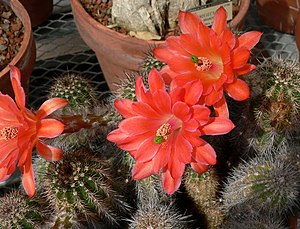Echinocereus polyacanthus
| Echinocereus polyacanthus | ||||||||||||
|---|---|---|---|---|---|---|---|---|---|---|---|---|

Echinocereus polyacanthus subsp. huitcholensis |
||||||||||||
| Systematics | ||||||||||||
|
||||||||||||
| Scientific name | ||||||||||||
| Echinocereus polyacanthus | ||||||||||||
| Engelm. |
Echinocereus polyacanthus is a species of plant in the genus Echinocereus from the cactus family(Cactaceae). The specific epithet polyacanthus is derived from the Greek words poly for 'many' and akantha for 'thorn' and refers to the thorny shoots of the species. English trivial names are “Giant Claret-Cup Cactus”, “Salmon-Flowered Hedgehog” and “Spiny” Hedgehog ".
description
Echinocereus polyacanthus grows individually or branched and often forms groups or cushions that consist of up to 400 shoots . The bright green to dark green cylindrical shoots taper towards both their base and their tips. They are 10 to 30 centimeters long and 2 to 7.5 centimeters in diameter. There are nine to 13 clearly pronounced smooth or humped ribs . The one to seven brown or yellow-brown central spines are thickened at their base. They have lengths of up to 5 centimeters, but are very variable in length. The six to 14 dirty white, often mutually overlapping radial spines are up to 2 centimeters long.
The tubular to funnel-shaped flowers are bright slightly pink- orange to deep red and have a yellowish or whitish throat. They appear near the shoot tips, are 3 to 14 centimeters long and reach a diameter of 2 to 8 centimeters. The egg-shaped green fruits contain white pulp and do not tear open.
Distribution, systematics and endangerment
Echinocereus polyacanthus is common in the United States in the states of Arizona and New Mexico . The distribution area extends further south to northern and central Mexico and includes the Baja California peninsula .
The first description was in 1848 by George Engelmann . Nomenclatory synonyms are Echinocereus triglochidiatus var. Polyacanthus (Engelm.) LDBenson (1944) and Echinocereus triglochidiatus subsp. polyacanthus (Engelm.) U. Guzmán (2003).
The following subspecies are distinguished:
- Echinocereus polyacanthus subsp. polyacanthus
-
Echinocereus polyacanthus subsp. acifer (Otto in Salm-Dyck) NPTaylor
flower diameter 6 to 8 centimeters -
Echinocereus polyacanthus subsp. huitcholensis (FACWeber) NPTaylor
flower diameter 4.5 to 8 centimeters -
Echinocereus polyacanthus subsp. pacificus (Engelm. ex Orcutt) Breckw.
Flowers up to 3 inches long
A synonym for the subspecies Echinocereus polyacanthus subsp. polyacanthus is Echinocereus durangensis Poselg. ex Rümpler (1885).
In the Red List of Threatened Species of the IUCN , the species is listed as " Least Concern (LC) ". H. listed as not endangered.
proof
literature
- Edward F. Anderson : The Great Cactus Lexicon . Eugen Ulmer KG, Stuttgart 2005, ISBN 3-8001-4573-1 , p. 203-204 .
Individual evidence
- ↑ Urs Eggli, Leonard E. Newton: Etymological Dictionary of Succulent Plant Names . Springer, Berlin / Heidelberg 2010, ISBN 978-3-642-05597-3 , p. 188.
- ^ Friedrich Adolph Wislizenus : Memoir of a Tour to Northern Mexico, Connected with Col. Doniphan's Expedition, in 1846 and 1847 . Washington 1848, p. 104 (online) .
- ↑ Echinocereus polyacanthus in the IUCN Red List of Threatened Species 2013.2. Posted by: Baker, M. & Van Devender, T., 2010. Retrieved January 25, 2014.

